#mosquitofishes
Explore tagged Tumblr posts
Text
Fish keepers, and even the professionally written texts intended for consumption by aquarists, are prone to what philosophers call faulty generalization. Specifically I am now considering the livebearers, and the commonplace assertion, nowadays, that they require hard and alkaline waters in order to thrive. This fact makes these fishes appealing to people in areas with such a water supply, not least because such water is by nature more buffered against attempts to make it more soft and acidic, than is soft and acidic water when you want to make it harder and more alkaline.
In principle, a livebearer is any fish that does not spawn externally. But to aquarists it refers to 'livebearing toothcarp' or those cyprinodontoid fishes with such a life history. These fish are not a natural descent group, independent of those retaining the external spawning habit; which is to say, livebearing toothcarp' are polyphyletic. However the most common such toothcarp' in the aquarium are a natural or monophyletic group, among the poecilid subclade. Aquarists who do not have a special hobbyist interest in 'wild livebearers', are almost always referring to the mollies, guppies, platies, and swordtails.
Mollies in the wild are fishes of estuaries and even shallow seas, and in laboratory conditions, they grow better in brackish conditions than in freshwater, and not well at a low pH. Natural selection surely shapes the tolerances of wild molly populations, as in laboratory studies, shortfin mollies (Mollienisia sphenops complex, including the black molly) tolerate up to 8 ppt, and introduced mollies of this type, have colonised marine environments without further human assistance, in the Gulf of Thailand. Also laboratory studies indicate that the pH when keeping black mollies, a donesticated morph of shortfin molly, should not drop lower than 7.
The other popular mollies, the sailfin mollies (M. latipinna complex), are naturally present in marine environments in the wild, and experimentally tolerate salinities of even 70 ppt or above, and do best at 10 to. 25 ppt. The ecological preference of shortfin and sailfin mollies, for different levels of salinity, holds not only in their natural range, but also where both are introduced in the Gulf of Thailand. Shortfin mollies have colonised the inner waters of the Gulf of Thailand, where salinity is reduced, and sailfin mollies have colonised further. As with shortfin mollies, they breed and grow normally at a pH value above 7, and thus are not suitable for the softwater aquarium either.
Guppies (Lebistes reticulata) might be close evolutionary allies of the mollies, yet they are also very different animals, as they lack the special herbivorous and saltwater specializations of their molly kin. Guppies are adaptable fishes that do best at a pH that is circumneutral, and although they can tolerate slightly brackish environments, they are typically absent from them in their natural range, being thus limited to the 'interface' between fresh and brackish water conditions. Guppies actually can thrive in waters that are on the soft and acidic side, but only when the parameters are nicely close to neutral.
Still more distantly related are the platies and swordtails of the genus Xiphophorus (X. maculatus and X. helleri) that inhabit freshwaters upriver of estuaries. Although these fishes possess some physiological tolerance of low salinities, up to 10 ppt, they prefer different habitats than do tbe similarly sized mollies. Like them, however, they prefer a pH and hardness above those of our softwater aquariums. Both platies (X. maculatus complex) and swordtails (X. helleri complex) should be maintained at a pH value above 7.
The 'wild livebearers' as a whole, tend also to prefer circumneutral to hard and alkaline water, though some species are especially adaptable and tolerant. Among these are a few species popularly known as the mosquitofishes, although confusingly a number of species in different genera have been referred to by that name, sometimes even the guppy. Usually in aquaria, two species of Gambusia are indicated, either G. affinis or G. holbrooki. These species are easily confused, and the aquarium trade rarely recognizes the difference.
The adaptability of these species to variables of water parameters, has often made them very successful outside of their native range, once they have been introduced to new, suitable localities by the hand of man. Gambusia sp. may be found in waters with a pH as low as 5 and as high as 10, but usually it is at least 6. The temperature is usually 25 degrees, a good match for our tropical tanks, but they may be maintained between 15 and 30 degrees centigrade. Also, they are able to handle a salinity that is up to 16 ppt.
The overlapping appellation of millionsfish is also used for a number of livebearer species, including again the guppy. Another is the dusky millionsfish or caudo, Phalloceros caudimaculatus, further known as the speckled mosquitofish in fact, and also as the one-spot livebearer. Like Gambusia sp. this little toothcarp has established new populations far outside its natural range, assisted by its inherent and broad environmental tolerances, and human efforts to control biting mosquito populations. Based on the collection records that exist for P. caudimaculatus populations, they naturalise best where the temperature is 16-22 degrees centigrade, and the pH is 6.5 to 8.
From North America hails another small poecilids species, Heterandia formosa, known as the least killifish and midget livebearer, as well as the dwarf topminnow. The latter being a North American colloquialism referring to the killifishes. H. formosa inhabits the still waters of pools, and slow moving streams, in association with dense vegetation. The species is reported from localities with a pH of 4.5, but between 5 and 7.5 is probably better. This species feeds normally, when the temperature is between 11 and 32 degrees centigrade.
Some other livebearers may be obtained that will do fine at a pH lower than 7. Two species that may be found together in the same habitat, are the merry widow, Phallichthys amates, and the knife livebearer, Alfaro cultratus. Both species are naturally present where the pH may be as low as around 6.5. Both fishes inhabit slow-flowing streams, creeks, and other backwater to stagnant waters, around vegetation, and usually over a mud bottom. Knife livebearers have overlapping but different habitat requirements, than does the sympatric merry widow, as they are commonest in forest pools and small creeks, and also in river edge habitats.
#livebearers#pH#water parameters#poecilids#mollies#guppies#platies#swordtails#mosquitofishes#millionsfishes#knife livebearer#merry widow#Mollienisia sphenops complex#Lebistes reticulata#Xiphophorus helleri complex#Xiphophorus maculatus complex#Mollienisia latipinna complex#Gambusia affinis#Gambusia holbrooki#Phalloceros caudimaculatus#Heterandria formosa#Alfaro cultratus#Phallichthys amates
0 notes
Text
Neat! I was recording this non-native little orange platyfish (I think) when another oddball stole the show! That salt-and-pepper fella is a melanistic male eastern mosquitofish, which is one of my favorite animal color mutations in the world. We’ve talked about them a little on this blog. You can also appreciate the more muted wild-type mosquitofish coloration (pale gray) in this video near the platy. Cool to catch all three at once!
246 notes
·
View notes
Text
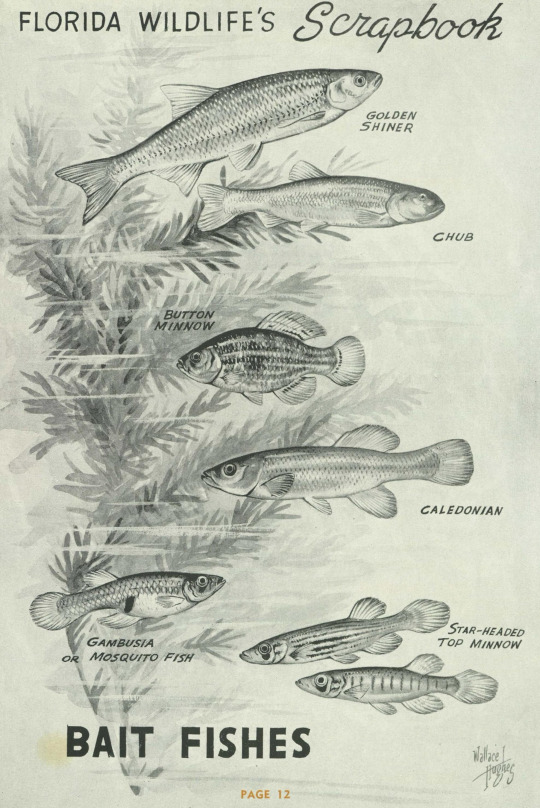
Florida Wildlife; vol. 9, no. 11. April, 1956. Illustration by Wallace Hughes.
Internet Archive
407 notes
·
View notes
Text

the western mosquitofish
#western mosquitofish#conservation#nature#biology#wildlife#fish#ichthyology#native fish#freshwater fish#fishing#fishblr#field biologist
57 notes
·
View notes
Text
About 1/4 of this sample sorted by species. Now I need to measure all of them. I am very bored.

#fish#science#biology#laboratory#cw dead animal#emerald shiner#mosquitofish#sunfish#freshwater drum#river shiner#bullhead minnow#brook silverside#spotfin shiner#i think#need to check the dicotomous key on that one
8 notes
·
View notes
Note
Can you give me a cute fish
The tiniest of guys

You get an Eastern Mosquitofish
Gambusia holbrooki
10 notes
·
View notes
Text


A delightfully chubby Least Killifish female and a very cute "dalmatian" melanistic Mosquitofish male, both caught with a net in the retention pond at work.
I love seeing the melanistic ones--they look like little fancy guppies in the middle of the pond. I find maybe 1 for every 200 regular fish.
3 notes
·
View notes
Note
what’s the best way to get into native fishkeeping? currently have 3 running tanks but no native species and im really interested in starting a native tank (florida based) but its really hard to find the resources to figure out how to get started 💔💔 any help would be appreciated :))
First thing I'd do is get a fishing license! Catching and keeping native fishes starts there. Make sure you pick up a copy of your local fishing regulations and read through them. Learn what is legal and what isn't - sometimes things like the number of specimens of a given species or method of catching are regulated. Always follow your local laws!
Second would be to learn what fish species you have locally. Just because a species is native to Florida doesn't mean you'll have easy access to it. I suggest you go wading in local creeks, streams, and bogs and see what you can find! Just uh watch for snakes and gators. I've stumbled upon a few while down your way. Maybe also look into iNaturalist to see what fish can be found in your area too.
Third, think about the biotope you want to try. You have great freshwater, brackish, and saltwater options. Don't overlook your native killifish and livebearers! Eastern Mosquitofish are somewhat drab in most areas, but in FL you can find a very handsome black and white marbled variant. They really stand out! Our Fundulus killies are all winners too. But the native burrfish, damsels, and sunfishes are all neat too!
Fourth, pick up a book on native fish keeping for some ideas. Our Native Fishes by John Quinn is a good one I like.
Maybe ask @floridafishkeeper their thoughts! They seem to be very knowledgeable on the local species.
35 notes
·
View notes
Text
VA Native Fish Hunting - 25
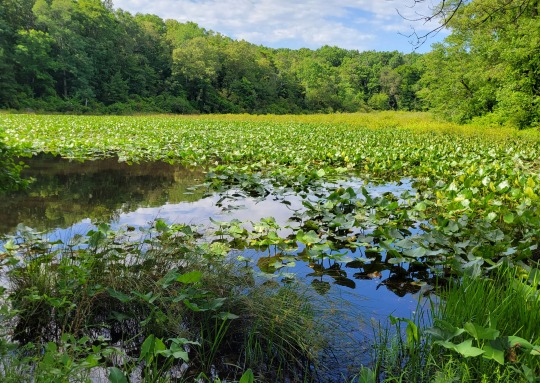
What a great day for some fishing! This is one of my favorite spots to spend a half hour knee-deep in swamp muck. Really, can't recommend it enough. Nothing new per se today but a couple of really neat finds.
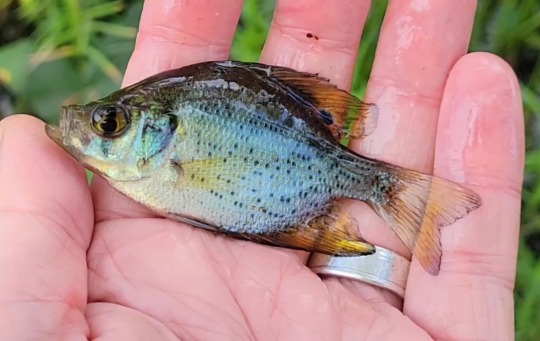
Let's start on a high note. My very first search landed me this GORGEOUS Flier (Centrarchus macropterus). I hadn't caught any in close to 3 years, and even those were just tiny inch long fry. This beaut was much larger and extremely impressive. I would like to one day have some in my 125 gallon tank, but since that's not free today, back he went.
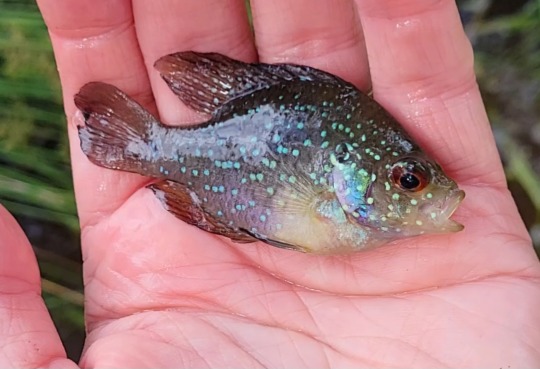
The next fish I caught was this Bluespotted Sunfish (Enneacanthus gloriosus). I love this fishing spot specifically because I can find these here, and in fact I caught maybe 5 BSSs today. Beautiful animals and highly recommend them for home keeping - definitely some of my favorite native fish!
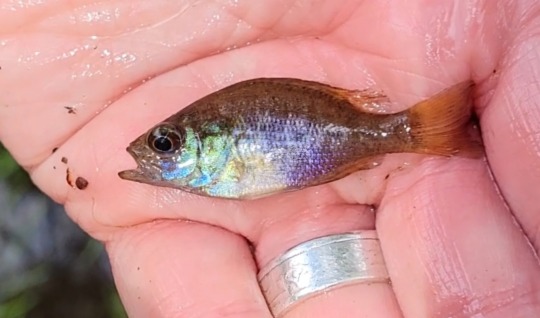
This little guy is not as straightforward as the last two. It's a Lepomis spp but it could be a few different species. With the wavy body lines, I would guess Warmouth, but could also possibly be Pumkpinseed or Bluegill. Regardless, it was a neat find today as I don't see many Lepomis here often.
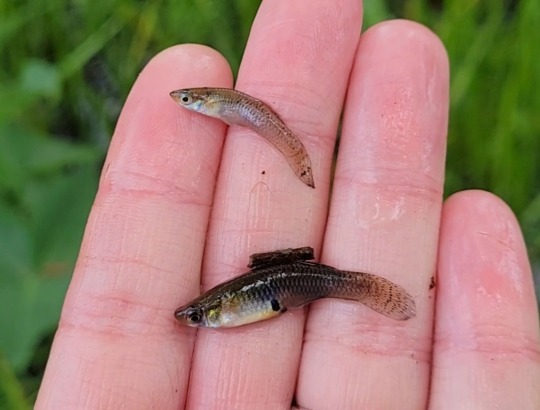
These Eastern Mosquitofish (Gambusia holkbrooki) are what I came for today actually. I used to have a dozen in my 55 gallon tank but they only live for about 2 years and I'm down to my last 4. So I caught 8 more, including 3 males. I personally like them but they get kind of a bad rap regarding aggression in my opinion.
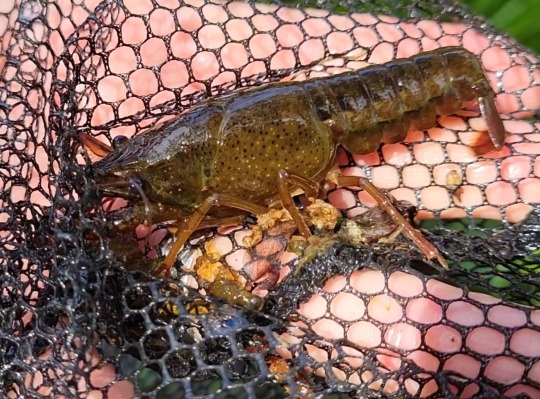
We also get a fair amount of crayfish in this area! Again, I'm not that knowledgeable about them, but I'm pretty sure it's a Cambarus spp. - maybe C. bartonii. Those seem to be common in my neck of the woods anyways.
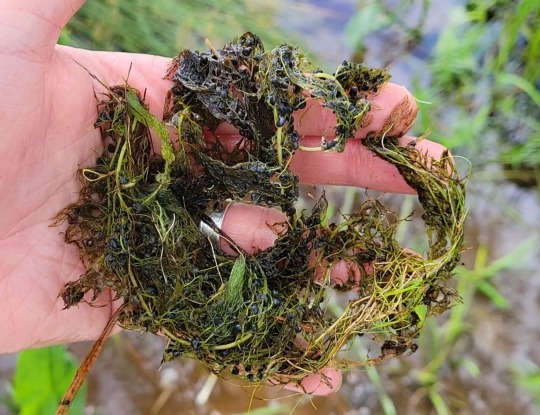
The most common submerged plant here were these bladderworts - also a very fun inclusion for home tanks. They are carnivorous plants but do perfectly well without being fed live animals. The only real caveat is that they don't seem to like extended stays under direct light.
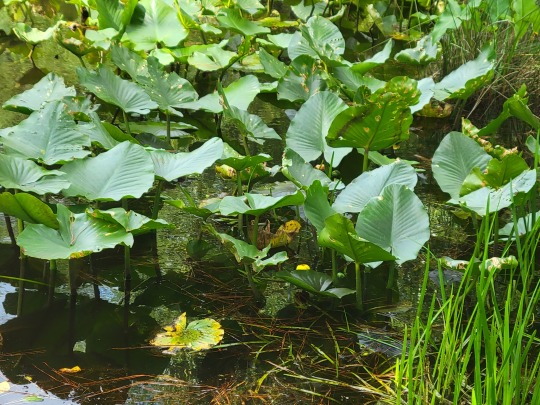
The other common plant here was this Spatterdock (Nuphar advena) which has spread quite a bit since I was last here earlier in the year. Much too big for home or pond usage honestly, but neat plants all the same.
41 notes
·
View notes
Text

Cyclopses (Cyclops spp.)
Family: Cyclops Family (Cyclopidae)
IUCN Conservation Status: Unassessed
Like the mythical creature from which they take their name, the members of the genus Cyclops (tiny freshwater-dwelling crustaceans growing to be around 0.5-5mm in length) are unusual among animals in that they have only one eye, which is compound and can be either black or red depending on the species, and is used along with their four highly sensitive antennae to locate food (mainly dead plant matter, single-celled organisms and smaller invertebrates such as water fleas) and avoid predators (such as mosquitofishes and barbels.) Found in stagnant or slow-moving water on every continent except Antarctica, Cyclops species swim jerkily forward by beating their ten tiny legs against the water and live for only around 3 months, although when faced with adverse conditions they can survive for prolonged periods in a dormant state by producing a thick coat of mucus to avoid dehydration. Cyclops species breed during the summer (with an increase in water temperature triggering their reproduction,) and following mating females produce a clutch of around 45 eggs which they carry in a pair of pouch-like structures on the underside of their body until they hatch. Under normal circumstances Cyclops pose no threat to humans, but if accidentally ingested through the drinking of the water they inhabit they have the potential to pass numerous species of parasites (particularly nematodes, some species of which such as the solely human-targeting Dracunculus medinensis rely entirely on Cyclops species as intermediate hosts) to animals that swallow them.
——————————————————————————
Image Source: https://www.inaturalist.org/taxa/244267-Cyclops
#Cyclops#cyclops copepod#zoology#biology#carcinology#copepod#copepods#crustacean#crustaceans#arthropod#arthropods#animal#animals#wildlife#African wildlife#Asian wildlife#European wildlife#North American Wildlife#South American wildlife#cosmopolitan wildlife#invertebrate#invertebrates#freshwater invertebrates#microbiology#pond life#pond wildlife#genus Cyclops
24 notes
·
View notes
Note
Back again with a question and update-!
(Do let me know if I ought to hold back on these lmao, I acknowledge it’s quite much,,)
Moving on from the realm of misinfo and hearsay, what are some *hypotheticals* you might have regarding brackish beasties?
I.e things you suspect to be the case, but have no concrete information for, as of yet
E.g that there exists somewhere a euryhaline Nudibranch or Echinoderm, or that Coastal Cattail Reeds are potentially brackish friendly alternatives to mangroves!
As for update;
Following your naming guidance, I have named Brotato’s contemporaries:
Bromato and Spudbud
Respectively.
They enjoy annihilating crickets and vigorously lunging themselves at floating flake foods.
I am enamored, to say the least.
Feel free to ask whatever! I'm happy to respond as I have time.
A few things I suspect...
I think most if not all families of fish have one or more brackish tolerant species. As far as I've found in research, there are a wider array of brackish tolerant fishes than most realize. Minnows, Glassfish, Gouramis, Rainbowfish, and Tetras - all freshwater aquarium fish generally, all have one or more commonly sold brackish species. Some families have brackish species that just don't get sold much; cardinalfish, sunfish, and needlefish come immediately to mind. I think if you searched hard enough, you'd find more.
Euryhaline (freshwater-to-saltwater) fish are pretty well known - Mollies, Mosquitofish, Sheepshead Minnows, Mummichogs, just a few that are known. But invertebrates almost never are thought of as such. I know at least one - the Volcano Snail, but I suspect there are many more. I also suspect amphibious crustaceans (hermits and the like) are more likely to fall into this category.
I suspect aquatic (vice emersed) plant tolerance of salt, unlike fish, is probably lower with regards to salt than normally suspected. If you wander through brackish marches, you'll not often note many aquatic species of plants present. Algae typically takes over in those areas. Even plants with some tolerance, like Java ferns, sometimes skew lower than their commonly accepted maximums would indicate. I'm not really sure what makes emerged plants (like mangroves) more likely to tolerate salty conditions - possibly roots being hardier than leaves, or lack of competition.
I think I've seen this confirmed (when I did look long ago, it had not been yet), but I'm pretty sure brackish tolerance is a function of kidneys - which doesn't matter a whole lot for aquarium keeping purposes, but I enjoy knowing how things work.
3 notes
·
View notes
Note
SHEPP HOW ARE YOU IM SO SLEEP DEPRIVED AND GIRED WHAT ISNGOHR FAVORITE FISH OF RHEB MONTN?
HGIIIIIII❤️❤️❤️ CURRENTTLYLY I AM SICK UM BUT LIKE OTHERWISE AWESOME 😁😁😁😁😁😁 CURRENT COOL FISH ARE MY NEW FISH BRIAN vvv

AND ALSO THIS MOSQUITOFISH I CAUGHT BECAUSE EINTHINK ITS REALLY PRETTY ❤️❤️

2 notes
·
View notes
Text
Worldbuilding: Water Features
Lakes, ponds, seeps, springs; they’re not just for pretty postcards. They make excellent visuals for your story, of course; just the mention of lake, and your readers will be transported to a memory of their own dealings with large bodies of water. It’s useful sensory shorthand. It also gives elements to your setting that characters can turn to their advantage.
Consider, for example, a water garden. It doesn’t have to be huge; you can get some nice results with a pot oh, about the size of a large metal trashcan. (Don’t use metal, though. Ceramic, plastic - something that won’t leach into the water.)
In this large pot you want to build up ledges or stands you can put other much smaller pots on. Different water and wetland plants like their roots at different depths, so plant them in the tiny pots and put each on the right depth of ledge. Do it well, and you can get in not just floating plants like duckweed and elodea, but water lilies, duck potato, arrowhead, iris, arums, pitcher plants, bladderworts, and maybe even cattails. Almost all of these have pretty blooms, and many are edible. (Yes, duckweed is edible.)
Where you have water, earth, and plants, you’ll have critters. Wriggly things, whirligig beetles, diving beetles... and, yes, mosquito larvae. Though a pot this size is also good for hosting a fair school of mosquitofish, and if you have real luck you’ll end up with a water tiger or three. (Who will also happily keep your mosquitofish from over-populating.)
All of these are potentially food for something, along with the pot itself being a water source. Meaning if your character has been isekai’d, kidnapped, or woken up with amnesia and has no clue what’s around, he could do worse than to spend the day (and night) hanging out and watching what comes to the water. A short list of critters that might show up even in an urban backyard includes bees, wasps, birds, cats, raccoons, snakes, frogs of all kinds... bears....
And most importantly, people. Kids in particular gravitate to water features like iron filings to a magnet. Observe the kids - observe if there are any kids - and your lost character will have a lot more information to judge if it’s safe to come out.
Also if you’re looking for a monster, unless it’s undead or inanimate, it probably needs water too. And wet dirt may give you a better chance of finding tracks, even for something that flies.
A little water garden doesn’t have to take up much space to be a useful, practical, and lovely addition to your setting. And if it’s a bigger water garden... well, a chase through the lily-pads down a mini-Amazon is not impossible. Caimans, jaguars and giant river otters at the writer’s discretion!
3 notes
·
View notes
Note
mosquitofish 🔥🔥🔥🔥👁👁☝
MOSQUITOFISH ❗️❗️❗️❗️❗️❗️

2 notes
·
View notes
Note
your ask box wanted an ask in it
do you like fish
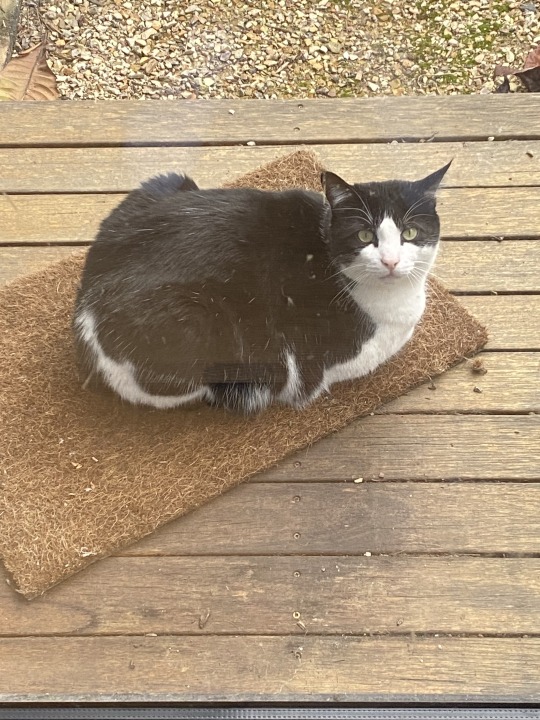
Who doesn't
I like all kinds of fishes
Here is my top 250 fishes
1. Salmon
2. Tuna
3. Cod
4. Trout
5. Bass
6. Snapper
7. Mackerel
8. Halibut
9. Swordfish
10. Sardines
11. Haddock
12. Flounder
13. Mahi-mahi
14. Catfish
15. Perch
16. Tilapia
17. Carp
18. Pike
19. Anchovy
20. Herring
21. Grouper
22. Sole
23. Barracuda
24. Bluefish
25. Redfish
26. Wahoo
27. Pompano
28. Yellowtail
29. Rockfish
30. Bluegill
31. Walleye
32. Whitefish
33. Rainbow trout
34. Lingcod
35. Skate
36. Bluefin tuna
37. Striped bass
38. Marlin
39. Sturgeon
40. Eel
41. Butterfish
42. Wolffish
43. Opah
44. Tilefish
45. Drum
46. Tilapia
47. Gurnard
48. Threadfin
49. Monkfish
50. Opaleye
51. Triggerfish
52. Cutlassfish
53. Pomfret
54. Bullhead
55. Croaker
56. Tautog
57. Sheepshead
58. Wrasse
59. Parrotfish
60. Hogfish
61. Porgy
62. Permit
63. Amberjack
64. Bonito
65. Tilefish
66. Croaker
67. Hogfish
68. Mullet
69. Ribbonfish
70. Drum
71. Saury
72. Tarpon
73. Mullet
74. Bluefish
75. Garfish
76. Wels catfish
77. Gizzard shad
78. Bowfin
79. Stickleback
80. Freshwater drum
81. Sucker
82. Bullhead
83. Sculpin
84. Mooneye
85. Goby
86. Chub
87. Mudminnow
88. Dace
89. Silverside
90. Lamprey
91. Minnow
92. Darter
93. Smelt
94. Sunfish
95. Sturgeon
96. Shad
97. Sablefish
98. Greenland cod
99. Hake
100. Grenadier
101. Cobia
102. Tilefish
103. Pollack
104. Oarfish
105. John Dory
106. Swai
107. Largemouth bass
108. Atlantic cod
109. Kingfish
110. Wolffish
111. Skate
112. Arctic char
113. Goby
114. Lumpfish
115. Gourami
116. Gar
117. Codling
118. Butterfish
119. Blenny
120. Wrasse
121. Roach
122. Rainbow smelt
123. Peacock bass
124. Pompano
125. Pikeperch
126. Minnow
127. Leatherjacket
128. Jackfish
129. Halibut
130. Gurnard
131. Grouper
132. Grunion
133. Grunt
134. Greenling
135. Grayling
136. Gray mullet
137. Grass carp
138. Goldfish
139. Golden perch
140. Ghost carp
141. Garfish
142. Fusilier
143. Flathead
144. Filefish
145. Electric eel
146. Dogfish
147. Doctor fish
148. Dory
149. Dolphin fish
150. Dolly Varden
151. Dogfish
152. Drum
153. Dusky grouper
154. Dunkleosteus
155. Dusky shark
156. Duckbill
157. Driftfish
158. Dragonet
159. Dorado
160. Donzella
161. Dolphinfish
162. Dogfish
163. Dogtooth tuna
164. Dogfish
165. Dory
166. Dusky grouper
167. Dunkleosteus
168. Dusky shark
169. Duckbill
170. Driftfish
171. Dragonet
172. Dorado
173. Donzella
174. Dolphinfish
175. Dogfish
176. Dogtooth tuna
177. Eel
178. Emperor
179. Eleuth
180. Elephantfish
181. Eelpout
182. Elver
183. Escolar
184. European flounder
185. European seabass
186. European perch
187. Flathead grey mullet
188. European eel
189. Eagle ray
190. Eastern mosquitofish
191. Eastern little tuna
192. Eastern mudminnow
193. European minnow
194. European sprat
195. Emperor tetra
196. Emperor angelfish
197. Emperor bream
198. Emporer red snapper
199. Emperor sole
200. Emperor shrimp
201. Emperor scorpionfish
202. Escolar
203. False trevally
204. False cat shark
205. False scad
206. False trevally
207. False cat shark
208. False scad
209. Fantail darter
210. Fathead minnow
211. Fathead sculpin
212. Featherfin squeaker
213. Fingerfish
214. Fire goby
215. Firefish
216. Flabby whalefish
217. Flagfish
218. Flat loach
219. Flathead catfish
220. Flathead grey mullet
221. Flathead
222. Flathead sole
223. Flounder
224. Flying gurnard
225. Flying fish
226. Freshwater butterflyfish
227. Freshwater drum
228. Freshwater eel
229. Freshwater garfish
230. Freshwater hatchetfish
231. Freshwater shark
232. Frigate mackerel
233. Frill shark
234. Frostfish
235. Fuji fish
236. Finescale triggerfish
237. Four-eyed fish
238. Fringe-scale sardine
239. Fullscale sculpin
240. Fulmar
241. Fusilier
242. Galjoen fish
243. Gaper
244. Garibaldi
245. Garpike
246. Ghost fish
247. Ghost flathead
248. Giant catfish
249. Giant danio
250. Giant gouram
What is your favorite fish ? :3
6 notes
·
View notes
Text
A fun alternative in this set up to keeping bug free if you live anywhere on the Mississippi river from Illinois to Mexico or on any of it's tributary rivers is:


Mosquitofish! Make sure to only keep them where native (listed above) or inside where's there's no possibility of invasive release but they are built for this job. They primarily eat mosquito larvae and even in a smaller pond can thrive in the dozens which is great for fertilizing the plants you grow as well 👍
#just make sure to check their NATIVE range when considering it and jot just current presence because they have been introduced#into areas for this purpose and wuickly become invasive#if you live outside these areas check your local freshwater fish line up and its likely you have a local boy who is just as good at it :D#plus its little guy estate dont you want little guys to watch and coo over
43K notes
·
View notes